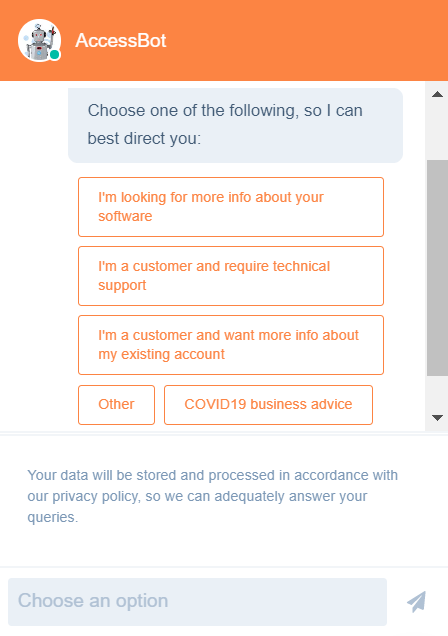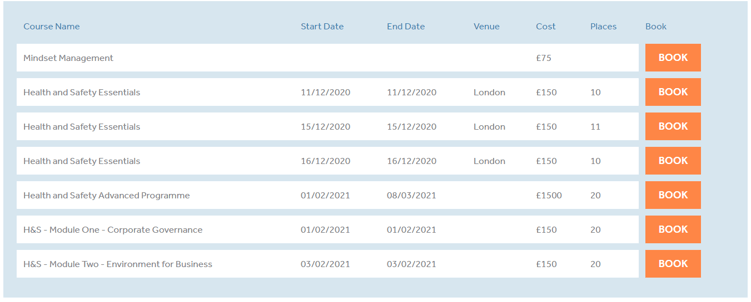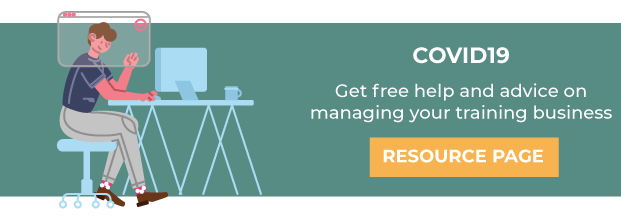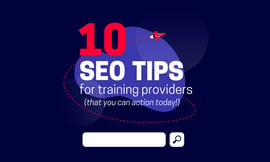7 Ways To Make Your Training Website Work Harder

Is your training website working hard or hardly working?
With more channels at our disposal than ever before to bring in website traffic, from social media to paid advertising and from search engines to email marketing, we need to ensure the place we're funnelling all this traffic is a destination visitors want to stay and explore.
Unfortunately, it's not uncommon in the training world for a website to be neglected; a boarded up shop window for your business that does little in terms of generating any, with business leaders still heavily reliant on the old methods of referrals, word or mouth and retraining opportunities to attract business.
If your aim is to improve the functioning and performance of your website and ultimately generate more course bookings, this guide offers some great tips on how to do just that.
The 7 Ways:
1. Content
2. Structure
3. Detail
4. Aesthetics
5. Accuracy
6. CTA's
7. Performance
1) Content
Analysing the effectiveness of the content on your website precedes everything else I'm about to mention. When I say content, I'm referring to any and all of the creative elements on your training website, usually comprised of both text and media resources.
Good content has the potential to elevate your position in search engine results, engage and entice visitors, encourage conversions and ultimately helps to build trust and authority in your brand.
Bad content can be defined as anything that is vague, irrelevant, redundant, confusing, false, or generally - serving no purpose.
With content, quality trumps quantity every single time. Therefore combining alike pages and posts to create better, more in-depth content is never a bad place to start.
Google Analytics is a great free tool for tracking website traffic by page and helping you to decipher what's helping you and what's not.
💡 How to do it: It's time for a content audit. If you're using a CMS, export all your website pages and analyse page view statistics, bounce rates, time spent on page and CTA click frequency. If a page has minimal views, low time spent on the page and no conversions, consider one of the following:
- Deleting it and redirecting the URL to a different page (301 redirect) Ahref's have a great blog on using 301 redirects for SEO.
- Rewriting the content to improve the quality
- Combining with another similar page
When creating new content, think about the contents purpose. It should serve one of the key 4 principles:
- To entertain: Useful within social posts and interactive media to give a human, approachable feel to your organisation
- To inform: It's of course useful to make visitors aware of your training offering and precisely what you provide.
- To educate: Is there a topic you know a lot about? This is your opportunity to share that knowledge. If you provide safety training, it could be a chance to highlight the importance of it!
- To convince: Why should delegates train with you? This is where you can be persuasive and use the sales & marketing tools at your disposal.
2) Structure
The content of your website means nothing without structure.
Thinking carefully about the different users that visit your website and the journey you want them to take can help you to define the structure of your website. Is there anything missing that you frequently get asked, either over the phone or via contact form?
When looking at site structure, you should focus on two key things:
- Organising your content into a meaningful flow, and ensuring the most important pages can be easily accessed on your website
- Indicating to Google what pages are most important to you. Submitting a sitemap is a great way to do this, however you can also build strong internal links to achieve a similar goal.
💡 How to do it: First we need to establish what our most important content is. For a training provider, it may look a little like this:
.png?width=1000&name=Homepage%20(1).png)
Once we've established our 'content tree' as above, we want to build powerful internal links within anchor text that aids easy navigation round our website and builds credibility on the pages we wish to elevate, both in search and general website navigation.
The key to an effective website structure is thinking about user intent. What did the visitor come to your site for? For example, it would be ineffective to try and shove blog posts in your visitors face whilst they're trying to book on a course. Or vice versa.
3) Detail
For training providers, vagueness is the enemy.
A training website lacking in detail is where the majority of smaller businesses and start-ups fall down. It may be thought "well, they know were here and can contact us with questions" or "I simply don't have time to fill all this in". The reality, is that your prospects will find a training website that's got more information pre-populated - negating the need for a telephone call.
Whether it's providing information about your organisation, the locations you operate at, the services you offer or how people should get in touch, ensure it's all specific, informative and up-to-date.
💡 How to do it: Use feedback to your advantage. Whether it's surveying current customers about their experience using your website, or simply asking new leads "did you find everything okay?"
It's impractical to think you can second guess every question a site visitor might have, so it's worth considering how you can make it easy for them to contact you. A great way to do this is with a chatbot!

4) Aesthetics
Online, looks matter. A visually pleasing website has the potential to retain a visitors attention for longer and it also gives a more professional feel. This doesn't mean you have to go out and sink thousands into a rebrand - most CMS's have functionality that will allow you to build media and design elements into a webpage without much technical know-how.
While aesthetics are great for user experience and credibility. ensure you don't sacrifice the usability!
Some of the most common areas to hone in on are things like website colours, the images you use, text & formatting and even things like white space/page breaks.
💡 How to do it: Beauty is in the eye of the beholder, and what works for one training business may not work for another. The best course of action is to speak to your marketing guru or brand contact. The first steps might be to create mood boards on Pinterest, or collate websites you've come across that you like. Once you've set a framework for brand guidelines and design, it should be easy to replicate moving forward.
It might be as simple as editing some text-heavy pages to make it easier to digest, or even just adding more titles and images.
How does your site look on mobile? More people than ever are browsing on their phones - one study found 44% of total web visits are now on mobile. If your website looks like a disjointed mess on a smartphone, not only is this terrible for aesthetics and usability, but it could also severely hurt you in search results, too!
5) Accuracy
Training businesses are ever-evolving. New staff come in, new courses are introduced, new learning solutions are implemented. If these big changes aren't reflected on your website, it can be both misleading for customers and a missed opportunity for your business!
Not only is it beneficial for the customer journey, however google tends to favour websites that are regularly updated in search rankings!
💡 How to do it: This just has to be one of those routine tasks for your diary. It may only need a once over every fortnight or so. Some of the most common pages to fall victim to outdated information include course dates, course catalogues, team information and recruitment vacancies!
Using a training management system is a great way to stay to ensure your course offerings stay fresh! It links directly with the course calendar in the core system, meaning updated course dates in real time!

6) CTA's
No website is complete with a few well placed call-to-actions. It is your opportunity to tell your web visitor what you want them to do next.
On some websites, it's impossible to find a phone number to call. It may even take a number of clicks to get to a contact form or email address. If you're looking to improve your website performance, then you also have to consider the user experience.
Not enough CTA's can be detrimental to conversions and cause a high bounce rate. Too many CTA's and visitors feel overwhelmed and too 'forced' in to their next move.
💡 How to do it: Assessing the performance of your CTA's is key. Whether it's a CTA to download an eBook, to enquire about a course or to book a course directly online, you want to know how many visitors took the action you wanted them to take on that page, as a percentage.
If not many visitors are converting through the CTA, there's a number of steps you can take to diagnose why. Is it in a prominent enough position? Could the wording be better? Does it relate to the on-page content? Is there enough value in the content to drive people to the CTA?
7) Performance
Nobody likes a slow website. Unfortunately, we're not a particularly patient generation.
One study suggests that a 2 second delay in load time can increase abandonment by up to 87%. What this means, is that if your website isn't optimised for speed, your visitors may well head elsewhere.
If that isn't bad enough, it also has the potential to impact your Google search rankings.
💡 How to do it: Ensure, first of all, that you're using a CMS that's not cause performance issues. It's worth heading over to Google's PageSpeed Insights, plugging your URL in and seeing how it ranks you. Things like image size & quantity, tracking codes and redirects are all culprits for slow page loading speeds.
Conclusion
In the advancing age of technology, it's imperative we invest in the tools that hold the highest potential for our success. A good website has the potential to both draw in new traffic, and keep previous visitors coming back.
If, historically, visitors have been few and far between, it's important to remember that you have to invest time before you see results. Sometimes, these results can take months to appear.
In time, improved content, site structure and technical optimisation will help you to climb search engine rankings and become more authoritative, bringing new traffic to your site. Visitors will spend longer on each page, referring their colleagues and adding bookmarks to your site.
Which of the seven points above would you like to improve on? Let us know in the comments!



